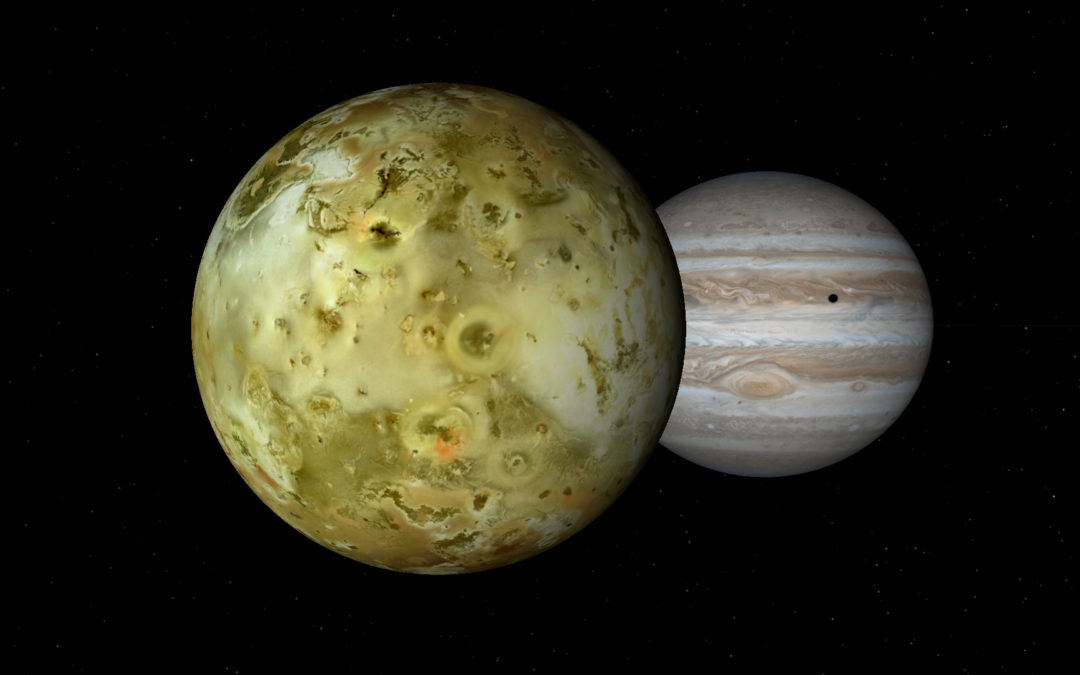In ancient times, people knew about the sun, the moon, the fixed stars, and exactly five “wandering stars” called planets. The movement of the planets was puzzling until Copernicus realized that the Earth too was a planet orbiting the sun just like the other five. But mankind’s knowledge the solar system exploded in the year 1610 thanks to a wonderful new invention: the telescope.
Hans Lippershey invented the telescope in the year 1608. He was a German-Dutch eyeglass maker, who found that a particular combination of lenses could make distant objects appear larger and closer than they do to the unaided eye. The following year, Galileo Galilei read about this remarkable instrument, and set about to build his own. By January 1610, Galileo had constructed one of the highest quality telescopes that existed at the time – though still very meager by modern standards. Galileo immediately set about exploring the night sky with his new creation and made several remarkable discoveries. He published a small book called “the Starry Messenger” in which he reported his findings and included instructions on how to build a telescope. Galileo found that the moon had mountains, valleys and craters. He found that there were vastly more stars in the Pleaides and in Orion’s belt and sword than could be detected by the unaided eye.
However, Galileo’s most remarkable discovery happened when he pointed his telescope at the planet Jupiter. He found that Jupiter had moons! No one had conceived of the possibility that other planets could have moons that orbit the planet, just as Earth’s moon orbits Earth. In fact, the idea was so novel, that Galileo did not even call them “moons” – a word that applied only to the moon at that time. Rather, these newly discovered moons looked like tiny bright stars in a telescope – stars that moved along with Jupiter. So Galileo referred to them as planets – wandering stars.[1] But unlike the other five planets that orbit the sun directly, these four new planets orbit around Jupiter. Humanity had known of five planets (not including Earth) for five and a half millenia. And in one week, Galileo discovered four more. His excitement about this discovery is evident in his writings.
The Starry Messenger
In the introduction to the Starry Messenger, Galileo writes,
But what surpasses all wonders by far, and what particularly moves us to seek the attention of all astronomers and philosophers, is the discovery of four wandering stars not known or observed by any man before us. Like Venus and Mercury, which have their own periods about the sun, these have theirs about a certain star that is conspicuous among those already known, which they sometimes precede and sometimes follow, without ever departing from it beyond certain limits. All these facts were discovered and observed by me not many days ago with the aid of a spyglass which I devised, after first being illuminated by divine grace.[2]
Note that he refers to the telescope as a “spyglass,” since the word ‘telescope’ had not yet been coined. Furthermore, Galileo concludes that these four new “planets” orbit Jupiter because they are sometimes ahead of Jupiter, and sometimes behind Jupiter in its motion through the heavens, as shown in the animation above. Jupiter’s rotation is not very tilted relative to its orbit around the sun, and hence we always see Jupiter nearly edge-on from our vantage point on Earth. Furthermore, the moons that Galileo discovered orbit in the plane of Jupiter’s equator, and so their orbits appear nearly edge-on. Consequently, they appear to go forward and backward as time progresses. Anyone with a small telescope can see Jupiter’s moons and will note that their positions relative to Jupiter change from night to night. Galileo’s discovery definitively proved that not everything in our solar system orbits Earth. This was a devastating blow to the geocentric (Earth-centered) solar system, and bolstered the heliocentric (sun-centered) model.
We now know that Jupiter actually has at least 79 moons! Most of them are very small – just a few miles across. But four are much larger – comparable in size to the Earth’s moon. These are the four discovered by Galileo. In honor of him, we refer to these as the Galilean satellites. They are very bright and can be seen in even a very modest telescope. In order of increasing distance from Jupiter, the moons are named Io, Europa, Ganymede, and Callisto. They are some of the most fascinating worlds of creation.
Orbital Properties of the Galilean Satellites
Io, the innermost of the Galilean Satellites, orbits Jupiter every 1.77 days at an average distance of 262,000 miles. That’s just a bit larger than the orbit of Earth’s moon, but the enormous gravity of Jupiter pulls Io around 15 times faster. Although the orbit is comparable in size to that of Earth’s moon, the planet Jupiter is much larger than Earth. So, in relative terms, Io orbits very close to its planet. Io orbits Jupiter at a distance of 6 Jupiter radii, whereas the moon orbits Earth at a distance of 60 Earth radii. Thanks to its short period, if you see Io on one side of Jupiter, the next evening you will likely see it on the other side of Jupiter.
The next moon out, Europa, orbits at a distance of 9.38 Jupiter radii with a period of 3.55 days. Notice that the period of Europa is twice that of Io. This is a 2:1 resonance. That is, when Io orbits Jupiter twice, Europa orbits Jupiter once. So, every two orbits of Io, it aligns with Europa. The next moon out, Ganymede, is also in resonance with both Io and Europa. Ganymede orbits at a distance of 15 Jupiter radii, with a period of 7.15 days – twice the period of Europa and four times that of Io. So, these three moons are in a 4:2:1 resonance.
Even more amazing is their configuration. Namely, whenever Io passes Europa, Ganymede is at a 90-degree angle relative to both of them. Whenever Europa passes Ganymede, Io is always on the opposite side of Jupiter, and the three moons form a straight line along with Jupiter. Whenever Io passes Ganymede, Europa is either on the opposite side, forming a straight line, or at a 60-degree angle. Apparently, this configuration has a stabilizing effect on these moons. In any case, no other known moons have such a unique orbital resonance.
Callisto, the outermost of the Galilean satellites, orbits at a distance of 26.3 Jupiter radii. Callisto has an orbital period of 16.7 days, and is not in resonance with the other three Galilean moons. All four Galilean moons are tidally locked. That is, like Earth’s moon, their rotational period matches their revolution period. Consequently, they keep the same face pointed at Jupiter at all times. This is true of all large moons, and many (but not all) small moons.
Since Jupiter has very little axial tilt relative to its orbit, and since the moons of Jupiter orbit around its equator, they often cast their shadow on Jupiter. These shadows are visible in a moderately-sized backyard telescope, appearing as a small black spot on Jupiter that slowly moves across its disk. You can use computer software or tables available on the internet to predict exactly when these events will occur. Jupiter will also cast its shadow on these moons when they are on the far side of the planet, rendering them invisible for an hour or so.
Every six years, the nodes of Jupiter’s equator align with the sun. For several months around this time, the Galilean satellites will occasionally cast their shadow on another Galilean satellite. This will cause the shadowed moon to fade rather dramatically and then brighten as the eclipse ends over the course of 15 to 30 minutes. Again, with modern technology these events are predictable to the second.
Physical Characteristics of the Galilean Satellites
Nine spacecraft have visited Jupiter. Of these, two (Galileo and Juno) went into orbit around Jupiter for an extended study. Thanks to these missions, we have detailed images and information on the Galilean satellites, as well as the other moons of Jupiter. To Galileo Galilei, these moons never appeared as anything more than bright stars. But we now know them as beautiful, diverse worlds, rich in detail.

Io is one of the most colorful, diverse, and unique moons in the entire solar system. Its strange rocky surface lacks the impact craters that are so common on all other solid worlds (except Earth). Instead, it has a yellow surface, with bits of orange/red and white, all due to various sulfur compounds. And Io is speckled with volcanoes. Unlike the dormant/extinct volcanoes on Mars, the volcanoes on Io are the most active in the entire solar system. When Voyager 1 flew past Jupiter, it detected nine erupting volcanic plumes on Io. Io is the most volcanically active world in the solar system. It has been completely resurfaced by volcanic activity since its creation.
Such extreme volcanic activity indicates that Io has significant internal heat. Since such heat cannot last billions of years, it may be evidence of the biblical timescale. Some heat can be generated in Io due to periodic tidal flexing caused when Io passes between Jupiter and Europa. Whether this generated heat is sufficient to last for the secular timescale is an open question.
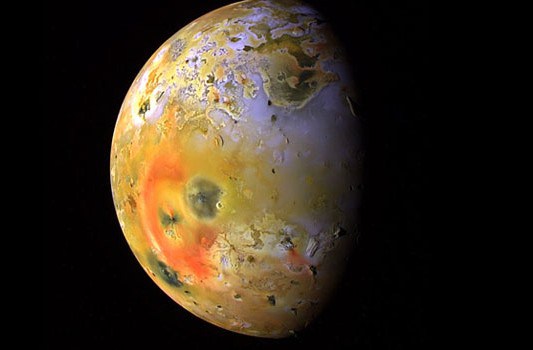
With a diameter of 2270 miles, Io is just 5% larger than Earth’s moon, and 22% more massive. The nearly constant volcanic eruptions and evaporating sulfur frosts generate a thin atmosphere. This is very unusual: most moons have no atmosphere at all. Io has a weak magnetic field, possibly induced from the enormously powerful magnetic field of Jupiter. The interplay of these magnetic fields has created a torus of charged particles along Io’s orbit. This plasma torus is the subject of ongoing research.
With a diameter 10% smaller than Earth’s moon, Europa is the smallest of the four Galilean satellites. Its composition is mostly silicate rock, but with a surface of mostly water ice, which produces its near-white color. The darker regions on the trailing hemisphere are thought to have greater mineral content. Europa has an unusually smooth surface. Could it have been warm enough to be liquid when first created?
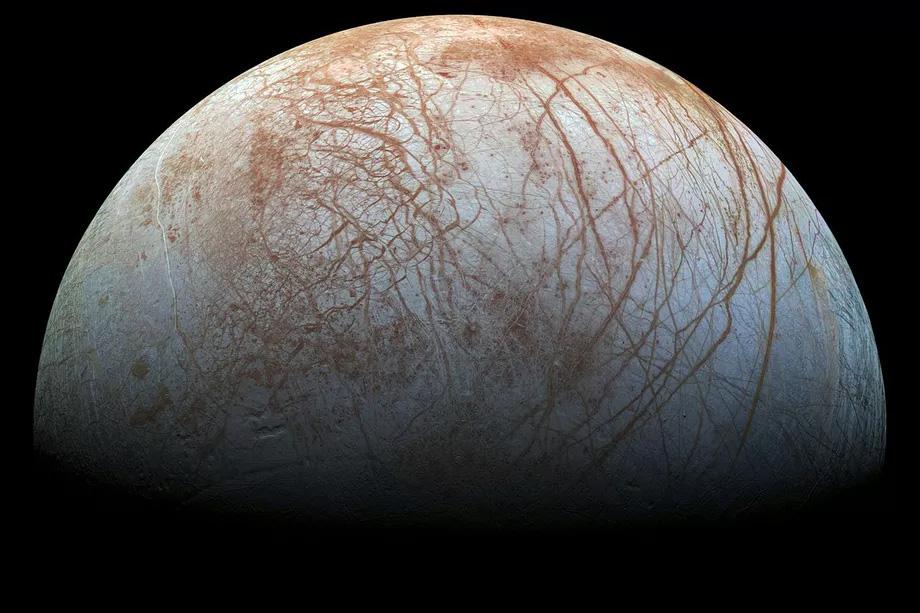
One of the most obvious and strange features of Europa are the large scratch marks along is surface. They are particularly prominent on the trailing hemisphere of this little moon. These are thought to be sites of cryogeyser activity – where the cracked surface has ejected plumes of water vapor due to internal heat. The Hubble Space Telescope has detected evidence of water plumes on Europa. Such internal heat is consistent with the biblical age of Europa – it has retained some of heat since creation. Tidal flexing may induce some internal heat, but Europa’s greater distance from Jupiter would make tidal forces weaker than they are for Io.

Next out is Ganymede. With a diameter of 3270 miles, it is the largest moon in the solar system. Ganymede is 51% larger than Earth’s moon, and is in fact 7% larger in diameter than the planet Mercury, though less than half as massive. Ganymede would undoubtedly be classified as a planet if it orbited the sun directly. But since Ganymede orbits Jupiter, it is a moon. Composed primarily of silicate rock and water-ice, Ganymede is the largest world without any substantial atmosphere. Due to its large size, Ganymede is often noticeably brighter than the other Galilean satellites as viewed through a telescope.
The surface appears tri-tone, with large dark brown regions resembling maria, interspersed with lighter brown regions, and speckled with white marks that appear to be ejecta from impacts. The lighter brown regions contain grooves and ridges, apparently the result of tectonic activity driven by internal heat. This is a problem for the secular timescale since such heat should have been exhausted long before the assumed secular age of these grooves. Ganymede’s orbit is too circular and too large for tidal flexing to produce any significant heat. Equally puzzling from a secular viewpoint is the existence of Ganymede’s magnetic field. This magnetic field is independent and not induced by the field of Jupiter. Yet, magnetic fields cannot persist for billions of years.
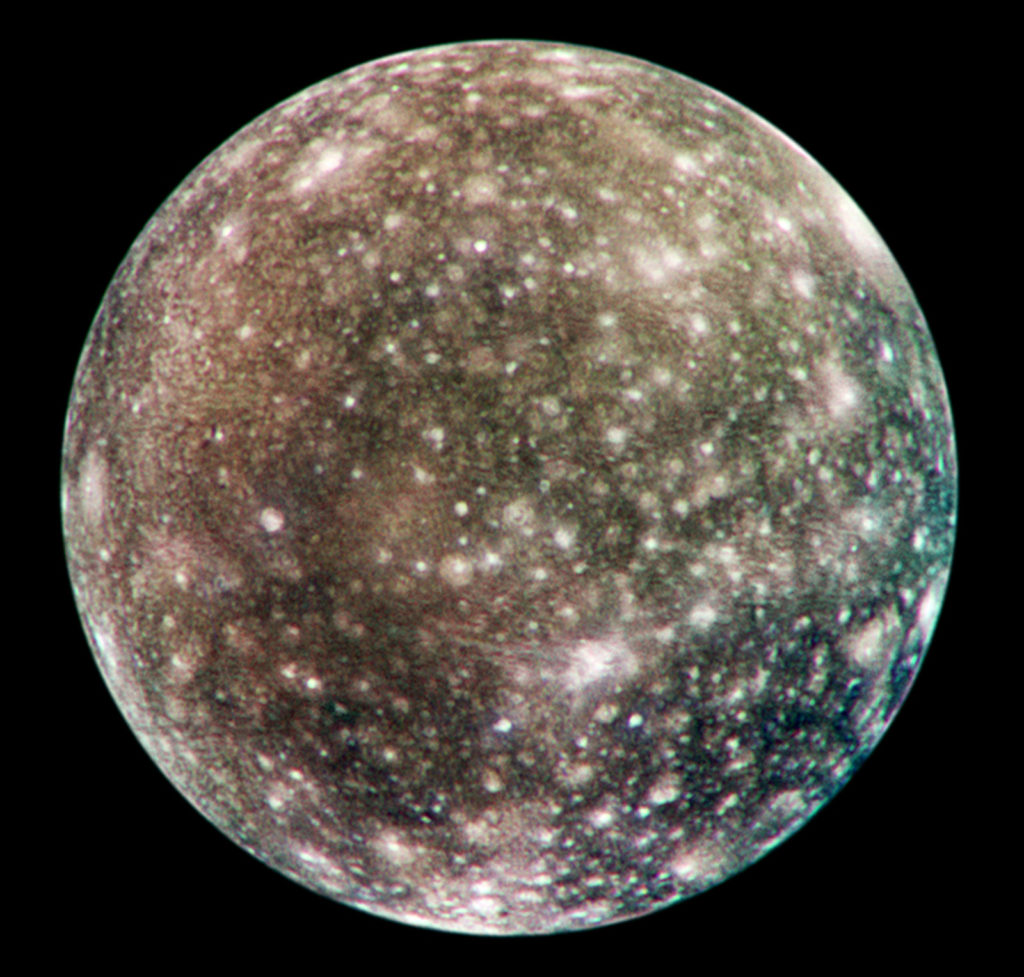
Callisto is the second-largest moon of Jupiter. It is 8% smaller than Ganymede in diameter, and 39% larger than Earth’s moon. It has a rocky/icy composition similar to the other Galilean satellites, but with lower density. Callisto lacks evidence of tectonic activity, and its surface is pockmarked with white craters.
Moons Galore
The remaining 75 known moons of Jupiter are far smaller and fainter than the Galilean satellites, which is why they evaded detection until centuries later. The next moon of Jupiter to be discovered was Amalthea in the year 1892, followed by Himalia in 1904. These are each just over 100 miles in diameter. Yet, all the remaining 73 moons are much smaller, typically just a few miles across. Exact diameters are not meaningful for these moons because they are generally not round.
Most of the moons of Jupiter fall into six natural groups based on their orbital characteristics. We have already covered the Galilean family. But four small moons orbits even closer to Jupiter than the Galileans. These are Metis, Adrastea, Amalthea, and Thebe. This group forms the “inner” family. Like the Galileans, these moons are classified as “regular”, meaning their orbits have low eccentricity (they are nearly circular), low inclination (they orbit very nearly in the same plane as Jupiter’s equator), and are prograde (orbit in the same direction Jupiter rotates). This is a design feature; moons that orbit so close to Jupiter and to each other must have very organized motion. They avoid collision by revolving the same direction, in the same plane, and with nearly circular paths.

The remaining 71 moons orbit farther than Callisto and are irregular. Most fall into one of the four remaining families and each family is named after a prominent member of the group. The next group out beyond the Galilean group is the Himalia group, named after the largest moon in the group. The seven moons of the Himalia group orbit prograde – in the same direction Jupiter rotates. But they do not orbit in the plane of Jupiter’s equator. Instead, their orbits are inclined to the equator by anywhere from 27 degrees to 31 degrees. Their orbits are not as circular as the inner and Galilean groups, but are not tremendously eccentric either. The average eccentricity of the Himalia family is 0.16 (recall zero would be a perfect circle, and closed orbits must be less than 1.0).
Next out, we find the Ananke group, which consists of at least 20 moons.[3] All these moons orbit retrograde (in the opposite direction in which Jupiter rotates). Their average eccentricity is around 0.23, so their orbits are a bit more eccentric than those of the Himalia group. All members of the Ananke group have an orbital inclination very close to 32 degrees.[4] So there is considerable organization even at this distance from Jupiter.
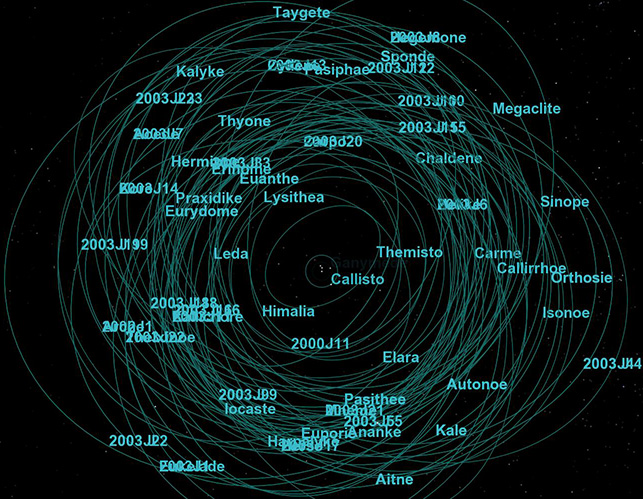
Next out are the Carme and Pasiphae groups. Both groups have retrograde orbits, and they overlap each other in terms of their distance from Jupiter. The Carme group has 22 moons. Each moon has an orbital inclination very near 15 degrees. The average eccentricity for moons in this group is 0.27, and so we see how eccentricities increase with increasing distance from Jupiter. The Pasiphae group has at least 17 moons.[5] They have an average orbital inclination of 32 degrees, just like the Ananke group, but with a much higher average eccentricity of 0.35 degrees.
Three irregular moons (Carpo, Themisto, and Valetudo) do not fall into any of these six families. Each of these three can be considered a family of one. All three are prograde with relatively high inclinations and eccentricities.
Patterns in Nature
The Jupiter system of moons is like a miniature solar system. The organization of the system is remarkable. The inner eight moons have low eccentricity, low inclination, and prograde orbits due to limited space. The outer moons can be either prograde or retrograde, and tend to have higher inclinations and eccentricities with increasing distance from the planet. This gives the outer moons a very disorganized look due to the apparent overlap of their orbits, but in fact we have seen that the orbits are organized into consistent groups. And since more space is available at extreme distances, there is greater diversity in orbital characteristics without any chance of collision. We will find that this is a common feature of the moons in our solar system, and of the solar system itself. We expect to find such patterns in nature because of the Lord who has imposed order on His creation.
| moon | avg distance (miles) | orbital period | diameter (miles) |
| Metis | 79,500 | 7 hrs, 4.8 mins | 25 |
| Adrastea | 80,200 | 7 hrs, 9.1 mins | 10 |
| Amalthea | 112,700 | 11 hrs, 57.1 mins | 129 |
| Thebe | 137,900 | 16 hrs, 12 mins | 27 |
| Io | 262,000 | 1.769 days | 2283 |
| Europa | 417,000 | 3.551 days | 1940 |
| Ganymede | 665,100 | 7.155 days | 3270 |
| Callisto | 1,169,900 | 16.69 days | 2995 |
| Themisto | 4,664,634 | 133 days | 5 |
| Leda | 6,937,609 | 240.9 days | 10 |
| Himalia | 7,121,535 | 250.6 days | 106 |
| Ersa | 7,135,205 | 252 days | 1 |
| Pandia | 7,161,303 | 253 days | 1 |
| Lysithea | 7,281,000 | 259.1 days | 22 |
| Elara | 7,295,000 | 259.9 days | 53 |
| Dia | 7,530,000 | 273 days | 2 |
| Carpo | 10,598,000 | 455 days | 2 |
| S/2003 J3 | 11,396,000 | 507 days | 1 |
| Valetudo | 11,761,000 | 532 days | 1 |
| Euporie | 12,015,000 | 549 days | 1 |
| S/2010 J 2 | 12,618,000 | 591 days | 1 |
| S/2003 J 18 | 12,743,000 | 600 days | 1 |
| S/2017 J 7 | 12,817,000 | 605 days | 1 |
| S/2016 J 1 | 12,832,000 | 606 days | 2 |
| S/2017 J 3 | 12,859,000 | 608 days | 1 |
| Mneme | 13,069,000 | 623 days | 1 |
| Euanthe | 13,073,000 | 623 days | 2 |
| S/2003 J 16 | 13,109,000 | 626 days | 1 |
| Harpalyke | 13,115,000 | 626 days | 2 |
| Praxidike | 13,141,000 | 628 days | 4 |
| Orthosie | 13,150,700 | 629 days | 1 |
| Thelxinoe | 13,151,000 | 629 days | 1 |
| Eupheme | 13,173,000 | 631 days | 1 |
| Ananke | 13,207,000 | 633 days | 17 |
| Helike | 13,212,216 | 633 days | 2 |
| Iocaste | 13,218,000 | 631.5 days | 3 |
| Hermippe | 13,233,000 | 634 days | 2 |
| Thyone | 13,233,000 | 635 days | 2 |
| S/2017 J 9 | 13,351,000 | 643 days | 1 |
| Aitne | 13,670,166 | 667 days | 2 |
| S/2017 J6 | 13,953,000 | 687 days | 1 |
| Philophrosyne | 14,118,000 | 700 days | 1 |
| S/2003 J 10 | 14,318,000 | 715 days | 1 |
| Pasithee | 14,348,000 | 717 days | 1 |
| S/2011 J 2 | 14,369,000 | 718 days | 1 |
| Eurydome | 14,382,000 | 719 days | 2 |
| Chaldene | 14,404,000 | 721 days | 2 |
| Isonoe | 14,435,000 | 723 days | 2 |
| S/2017 J 5 | 14,436,000 | 723 days | 1 |
| S/2017 J 8 | 14,436,000 | 723 days | 1 |
| Kallichore | 14,463,000 | 726 days | 1 |
| Erinome | 14,469,000 | 726 days | 2 |
| S/2017 J 2 | 14,480,000 | 726 days | 1 |
| Kale | 14,482,000 | 726 days | 1 |
| Eukelade | 14,492,000 | 727 days | 2 |
| Arche | 14,510,000 | 728 days | 2 |
| Taygete | 14,517,000 | 729 days | 3 |
| S/2003 J 9 | 14,531,000 | 731 days | 1 |
| Carme | 14,542,571 | 731 days | 29 |
| Herse | 14,545,000 | 732 days | 1 |
| S/2011 J 1 | 14,569,000 | 733 days | 1 |
| S/2010 J 1 | 14,571,000 | 734 days | 1 |
| S/2003 J19 | 14,623,000 | 737 days | 1 |
| S/2017 J 1 | 14,631,000 | 738 days | 1 |
| Kalyke | 14,643,000 | 739 days | 3 |
| S/2003 J 23 | 14,644,000 | 739 days | 1 |
| Hegemone | 14,649,000 | 739 days | 2 |
| Pasiphae | 14,682,000 | 741 days | 37 |
| Eirene | 14,746,000 | 747 days | 2 |
| Sponde | 14,782,000 | 749 days | 1 |
| Cyllene | 14,789,000 | 750 days | 1 |
| Megaclite | 14,797,000 | 750 days | 3 |
| S/2003 J 4 | 14,869,000 | 756 days | 1 |
| Sinope | 14,877,000 | 757 days | 24 |
| Aoede | 14,897,000 | 758 days | 2 |
| Autonoe | 14,936,000 | 761 days | 2 |
| Callirrhoe | 14,974,000 | 764 days | 6 |
| Kore | 15,212,000 | 782 days | 1 |
| S/2003 J2 | 17,614,000 | 975 days | 1 |
In the next article, we explore the lord of the rings: Saturn.
[1] The creation scientist Johannes Kepler in the 1610s was the first person to refer to Jupiter’s moons as “satellites” from the French word referring to an attendant or follower. Hence, any object orbiting a planet is a satellite. With the advent of modern space technology, we now have artificial satellites. And so, by contrast we refer to the moons of Jupiter as natural satellites, or more colloquially as moons.
[2] Galileo was not claiming here to be the first person to make a telescope. He mentioned in this same publication that someone else had already discovered that putting two lenses in combination could make distant objects appear much closer. But Galileo had received no detailed instructions on how to do this. So he began experimenting with combinations of lenses on his own, until he discovered how to make a telescope and to compute the magnification. He shared these details in the Starry Messenger, hoping that others would also build a telescope and begin exploring the heavens leading to new discoveries.
[3] There is one unconfirmed member of the Ananke group, which would make the count 21. Unconfirmed moons are included in the 79 count.
[4] The inclination is often listed as 147 degrees due to their retrograde direction, and similarly for other retrograde moons.
[5] As with the Ananke group, there is one unconfirmed member of the Pasiphae group, which would bring the number up to 18.

